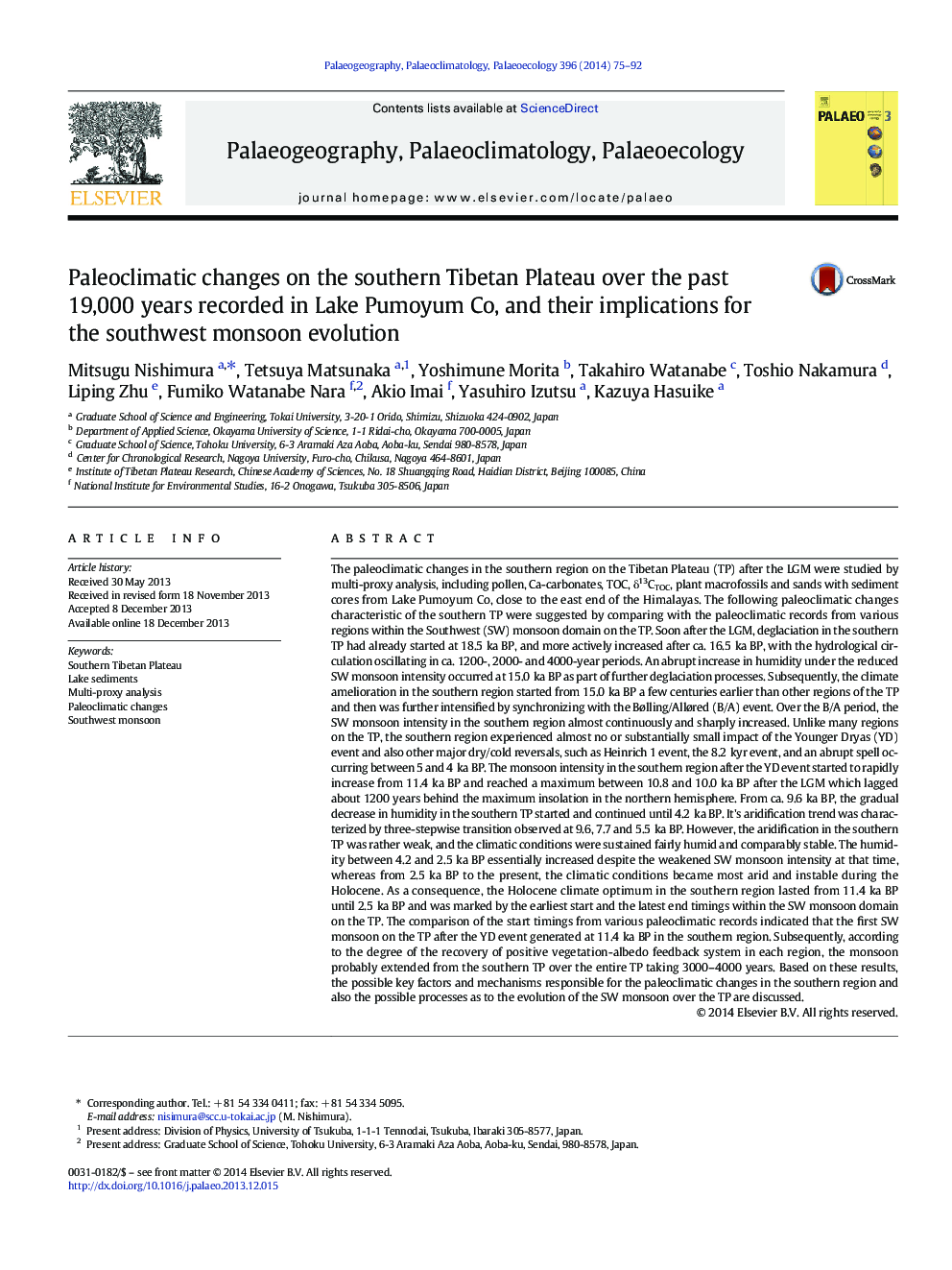| کد مقاله | کد نشریه | سال انتشار | مقاله انگلیسی | نسخه تمام متن |
|---|---|---|---|---|
| 4466408 | 1622194 | 2014 | 18 صفحه PDF | دانلود رایگان |

• We reconstructed the paleoclimate in the southern Tibetan Plateau (STP) since 19 ka.
• The paleoclimate was ameliorated earliest within the SW monsoon domain on the TP.
• The STP experienced almost no impact from all major dry/cold reversals.
• The first SW monsoon on the TP after the Y.D. generated at 11.4 ka BP in the STP.
• Subsequently, the monsoon extended from STP over the entire TP taking 3–4 kyr.
The paleoclimatic changes in the southern region on the Tibetan Plateau (TP) after the LGM were studied by multi-proxy analysis, including pollen, Ca-carbonates, TOC, δ13CTOC, plant macrofossils and sands with sediment cores from Lake Pumoyum Co, close to the east end of the Himalayas. The following paleoclimatic changes characteristic of the southern TP were suggested by comparing with the paleoclimatic records from various regions within the Southwest (SW) monsoon domain on the TP. Soon after the LGM, deglaciation in the southern TP had already started at 18.5 ka BP, and more actively increased after ca. 16.5 ka BP, with the hydrological circulation oscillating in ca. 1200-, 2000- and 4000-year periods. An abrupt increase in humidity under the reduced SW monsoon intensity occurred at 15.0 ka BP as part of further deglaciation processes. Subsequently, the climate amelioration in the southern region started from 15.0 ka BP a few centuries earlier than other regions of the TP and then was further intensified by synchronizing with the Bølling/Alløred (B/A) event. Over the B/A period, the SW monsoon intensity in the southern region almost continuously and sharply increased. Unlike many regions on the TP, the southern region experienced almost no or substantially small impact of the Younger Dryas (YD) event and also other major dry/cold reversals, such as Heinrich 1 event, the 8.2 kyr event, and an abrupt spell occurring between 5 and 4 ka BP. The monsoon intensity in the southern region after the YD event started to rapidly increase from 11.4 ka BP and reached a maximum between 10.8 and 10.0 ka BP after the LGM which lagged about 1200 years behind the maximum insolation in the northern hemisphere. From ca. 9.6 ka BP, the gradual decrease in humidity in the southern TP started and continued until 4.2 ka BP. It's aridification trend was characterized by three-stepwise transition observed at 9.6, 7.7 and 5.5 ka BP. However, the aridification in the southern TP was rather weak, and the climatic conditions were sustained fairly humid and comparably stable. The humidity between 4.2 and 2.5 ka BP essentially increased despite the weakened SW monsoon intensity at that time, whereas from 2.5 ka BP to the present, the climatic conditions became most arid and instable during the Holocene. As a consequence, the Holocene climate optimum in the southern region lasted from 11.4 ka BP until 2.5 ka BP and was marked by the earliest start and the latest end timings within the SW monsoon domain on the TP. The comparison of the start timings from various paleoclimatic records indicated that the first SW monsoon on the TP after the YD event generated at 11.4 ka BP in the southern region. Subsequently, according to the degree of the recovery of positive vegetation-albedo feedback system in each region, the monsoon probably extended from the southern TP over the entire TP taking 3000–4000 years. Based on these results, the possible key factors and mechanisms responsible for the paleoclimatic changes in the southern region and also the possible processes as to the evolution of the SW monsoon over the TP are discussed.
Journal: Palaeogeography, Palaeoclimatology, Palaeoecology - Volume 396, 15 February 2014, Pages 75–92